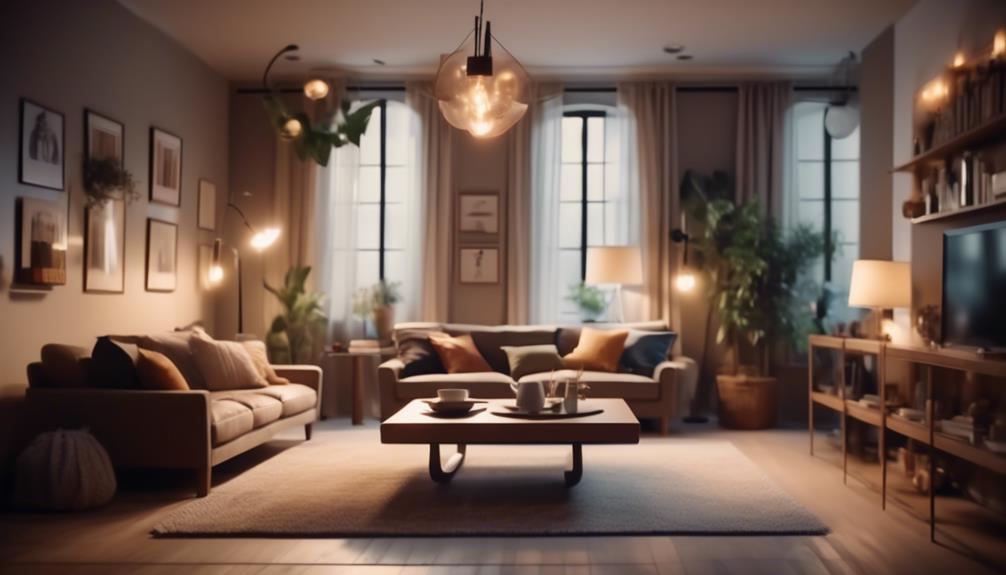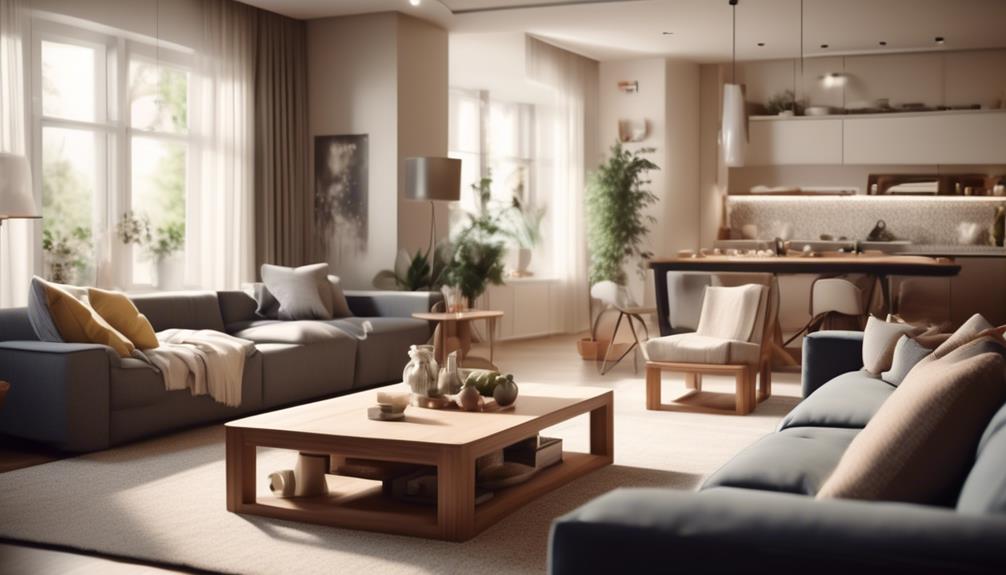In the expansive realm of open-concept living, arranging your furniture can seem like navigating through uncharted seas. Your mission is to craft a space that is both practical and aesthetically pleasing, a task that requires a sharp eye for detail and a solid understanding of how to utilise space effectively.
By dividing your open area into zones with strategically placed rugs, you'll start to recognise the formation of distinct living, dining, and working areas. Yet, the voyage doesn't end here. With appropriate focal points, modular furniture that adapts to your lifestyle, a harmonious colour palette, and lighting that acts as natural dividers, you'll discover that maximising your space isn't merely about arranging furniture. It's about crafting an environment that mirrors your lifestyle and needs.
Stay with me, and I'll share insights that will transform your open-concept area into a haven where every square metre serves a purpose, without feeling overcrowded or disconnected.
When it comes to staging a home to enhance its value and accelerate the sale process, the principles of open-concept living play a pivotal role. Estate agents often highlight the importance of presenting a home that not only appeals visually but also demonstrates functional living spaces that potential buyers can envision themselves in. By adopting these strategies, you're not just organising furniture; you're curating an inviting atmosphere that speaks volumes to prospective buyers, ensuring your property stands out in the competitive market.
Defining Zones With Rugs
To enhance the appeal of different areas within an open-plan layout for staging purposes, consider the strategic placement of rugs that both complement your furnishings and distinctly demarcate separate zones. Rugs can be a pivotal tool in creating an inviting atmosphere that potential buyers can envision themselves in, effectively guiding them through various sections of the property. By selecting rugs of appropriate sizes, you anchor furniture arrangements and establish clear boundaries without the need for physical barriers.
Envision a snug rug positioned under your coffee table, immediately signifying the living space, or a chic, contemporary design placed beneath your dining table, marking out the dining area. These elements aren't merely decorative; they serve as visual indicators that improve the flow of the property. Opting for coordinating patterns or shades can further unify these spaces, fostering a cohesive aesthetic that welcomes and reassures.
Furthermore, thoughtfully positioned rugs can influence the movement flow, subtly directing traffic between the social, dining, and relaxation zones of the home. They transcend mere functionality; they embody your intention to present a property where every nook, every rug, indicates a space where potential buyers feel a genuine sense of belonging.
For those preparing their homes for viewings, incorporating these strategies can't only increase the property's appeal but potentially expedite the sale process. Estate agents often highlight the importance of such details in making a property more attractive to prospective buyers.
Focal Point Strategies
Crafting a visually striking open-plan space, incorporating distinct focal points in each area can significantly elevate both its aesthetic appeal and functionality. By selecting standout elements that catch the eye, you're not merely decorating; you're creating spaces where memories are forged and shared. Envision a striking piece of artwork in your living area or a unique light fixture above your dining table—these aren't just objects. They're conversation starters, elements that bring people together.
When staging a house for sale, each adjacent space within your open-plan layout deserves its own focal point. This doesn't only add to the visual allure; it defines each area without the need for walls. You're not just arranging furniture; you're sculpting your living space, making each corner a testament to your style and a place where everyone feels they belong. This strategic approach is recommended by estate agents as a way to increase a property's value and accelerate its sale.
Use striking features judiciously. A bold colour accent, an eye-catching piece of furniture, or an impressive architectural feature can all serve as focal points. These elements make your space more functional and inviting, turning your home into a haven where every area has its own story, its unique charm, and a sense of belonging that welcomes everyone in.
This isn't just about making a space that looks good; it's about creating an environment that feels welcoming and enhances the likelihood of a quick and profitable sale.
Modular Furniture Benefits
As you delve into the benefits of modular furniture, its versatility and adaptability become key in enhancing both the functionality and aesthetics of open-plan spaces, particularly when staging a house to increase its value and ensure a quicker sale.
This type of furniture not only accommodates a variety of living spaces and needs but also allows for easy rearrangement and reconfiguration to suit different room layouts and purposes. It's akin to having a design toolkit at your disposal, enabling you to revitalise your space whenever desired.
Envision the possibility of mixing and matching modular pieces to create bespoke furniture arrangements that align perfectly with your individual tastes. This flexibility proves especially useful for open-plan living, offering limitless options for defining and dividing spaces without disrupting the flow or sense of unity in your home.
Moreover, many modular furniture options come with built-in storage solutions, maximising space efficiency and aiding in maintaining tidy and organised open living areas.
For those looking to sell their home, consulting with estate agents often reveals the importance of presenting a well-designed, versatile space to potential buyers. Modular furniture can play a pivotal role in this, allowing you to tailor your home's layout and appearance to showcase its best features, thus potentially increasing its market value and enhancing sale prospects.
Color Palette Cohesion
When preparing your open-plan property for market, selecting a cohesive colour palette is essential to seamlessly integrate different areas, thereby creating a unified and welcoming atmosphere. This strategy ensures that despite the absence of walls, your home conveys a sense of connection and harmony. You're not merely decorating spaces; you're crafting a sanctuary where every corner communicates the same visual language, enhancing the property's appeal to potential buyers and possibly increasing its value.
Consider the natural light pouring into your room. It plays a critical role in how colours appear and interplay. Opting for a palette that harmonises well with both morning and evening light can significantly improve the cohesion and balance of your space. It's about establishing a flow that feels both natural and inviting.
Utilising colour to link different zones within your open-plan layout promotes continuity. Envision a colour thread weaving through your living area, dining space, and kitchen, subtly uniting them. Warm and cool tones should find harmony within your chosen scheme, offering a visually pleasing and comforting environment that appeals to potential buyers and estate agents alike.
Lighting as a Boundary

After establishing a cohesive colour palette, it's essential to consider how lighting can act as a boundary, effectively dividing spaces without the need for physical barriers. You're not just illuminating your home; you're creating areas where memories are made, with every light fixture playing a vital role in this delicate balance of separation and unity.
To distinguish different areas, install eye-catching light fixtures that draw attention yet feel inherently connected to your space. Choose fixtures that echo materials, colours, or finishes found elsewhere in your open-concept area. This strategy ensures a seamless flow, creating an environment where you and your loved ones feel a profound sense of belonging.
Furthermore, embrace the power of variety by selecting lights with distinct silhouettes to emphasise the separation of spaces. Drum shades, for instance, are perfect for casting a soft, ambient glow, marking a transition from one activity zone to another without the harshness of physical walls.
When preparing a house for the market, it's essential to stage it in a way that increases its value and speeds up the sale process. Estate agents often highlight the importance of effective lighting in achieving this goal. By strategically placing light fixtures, you can transform the perception of your home, making it more appealing to potential buyers in the UK. This approach not only enhances the aesthetic appeal of your property but also demonstrates the potential of each space, allowing buyers to envision themselves living there.
Frequently Asked Questions
How Do You Arrange Furniture in an Open Concept Floor Plan?
To stage a house effectively for a quicker sale and to increase its value, especially within an open plan layout, it's vital to coordinate colours and styles harmoniously. Utilise area rugs to demarcate distinct zones, position a console table behind your sofa for added elegance, and ensure that walkways are at least 90 centimetres wide for ease of movement. In the UK, such attention to detail can significantly appeal to potential buyers, as advised by estate agents who understand the local market nuances.
Where Should a Dining Table Be Placed in an Open Floor Plan?
In staging a house for a quicker sale and potentially increasing its value, placing your dining table close to the kitchen within an open floor plan is recommended by estate agents. This positioning fosters a seamless transition during meals and social gatherings, ensuring that everyone feels integrated and part of the communal atmosphere of the space.
How Do You Maximize Space With Furniture?
To maximise space when staging your home for a quicker sale and to increase its value, it's pivotal to select versatile furniture pieces that serve multiple functions and to arrange them in a way that clearly defines different areas. Using rugs to demarcate zones and paying attention to the scale of furniture pieces can ensure the space feels both cohesive and expansive. Remember to consult with estate agents for tailored advice on presenting your property in the best possible light to potential buyers in the UK market.
How Do You Divide Open Concept Space?
To segment an open-plan space when staging a house for a quicker sale and to elevate its value, consider strategically positioning furniture and utilising area rugs to demarcate distinct areas. Introducing console tables and being mindful of sightlines guarantees a seamless yet inviting atmosphere. Consult with estate agents for tailored advice to ensure your home appeals to the UK market.
Conclusion
In conclusion, bear in mind that demarcating areas with rugs, establishing focal points, and opting for modular furniture can significantly enhance your open-plan space. Adhere to a harmonious colour palette to unify the area, and don't underestimate the impact of lighting in setting boundaries. By adhering to these suggestions, you'll not only maximise your space but also create a functional, flexible living environment that's both welcoming and stylish.
Thus, embark on rearranging, and witness your open-plan space transform before your eyes.
When preparing your home for the market, these strategies aren't just about creating an aesthetic appeal but are pivotal in staging your house to augment its value and facilitate a quicker sale. Estate agents often highlight the importance of presenting a home that feels both spacious and inviting, as it significantly influences potential buyers' perceptions. So, take this opportunity to refine, adjust, and watch as your open-plan area evolves, potentially speeding up the process of finding the right buyer for your home.

